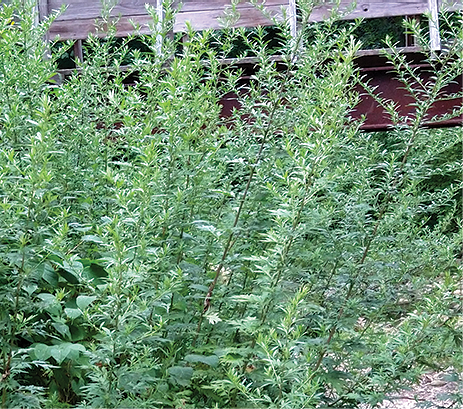Find it
September is the perfect time to take action on mugwort, an aggressive perennial that rapidly takes over uncultivated and disturbed areas such as streambanks and waysides. It grows to six feet or more in a single season, blooming in August and September in Granby. It grows in all kinds of well-drained soil, grows rapidly and densely in sun or part shade, and is drought tolerant. It has a host of names and resembles a tall, leggy chrysanthemum.
Mugwort’s aromatic leaves have been used beneficially across the globe for centuries for a wide variety of purposes—to flavor beer, as tea, in cooking, as incense, as an insect repellent, as a dream stimulant, and medicinally to treat scores of ailments. It is considered dangerous in large doses, especially during pregnancy, can be a skin irritant, and its pollen is a common cause of hay fever.
Mugwort is sometimes confused with wormwood (Artemisia absinthium), which has an equally long list of potential uses.
Why it’s a problem
Native to Europe and Asian countries, Mugwort has been present in North America for centuries. It has recently become clear that it is aggressively invasive, especially in the northeast, crowding out other plants and creating monocultures.
Mugwort spreads aggressively in two main ways. Through extensive and strong rhizomes (underground horizontal stems that produce roots below and shoots above ground), it forms dense clumps that expand every year. Once established, mugwort clumps are difficult to dig up, and small rhizome bits can start new clumps.
Mugwort also spreads by seeds that appear in the fall after flowering; each plant produces tens of thousands of seeds. Mugwort produces chemicals that are toxic to competing plants and are not eaten by deer and other grazers.
What to do
Cut it! Repeated mowing, cutting and weed-whacking, twice each season but especially in late summer/early fall, prevents seeds from maturing and gradually weakens clumps over several seasons. Do not cut mugwort in late fall—that helps distribute seeds and start new clumps.
Dig it! Carefully dispose of all rhizome parts so they do not start new plants.
Use it! Harvest leaves and other parts and carefully follow tested ways to use it.
For more information on invasive plants, visit:
granbyinvasiveplants.weebly.com
